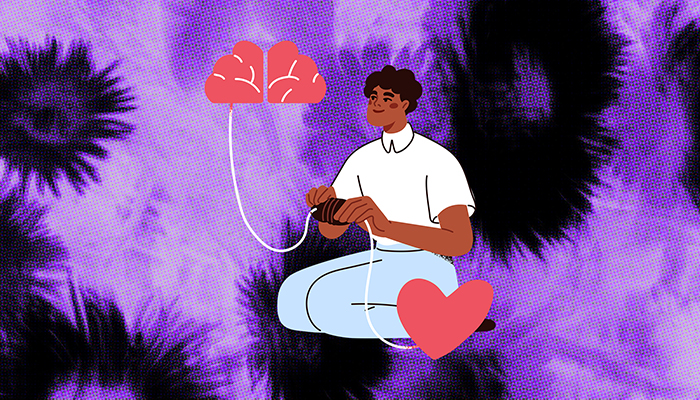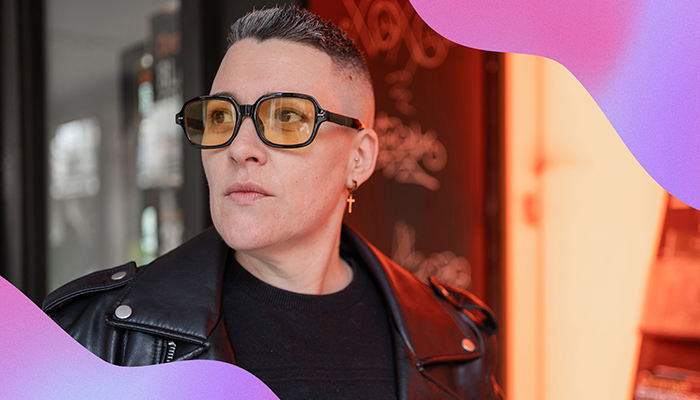This article was written by Summer. Photos are also provided by Summer and edited by Isabel.
Content note: This article discusses weight loss and other content related to eating disorders.
It began quietly. I wanted to shave off a few pounds to look more “girlish.” You know, smooth out the belly a bit. It seemed like a great idea—slow down my eating to save some money and cultivate the body I wanted.
I didn’t know the idea could avalanche into an eating disorder. Most of all, I didn’t know that recovering from disordered eating would be a lifelong endeavor.
Matching scripts to life
Every trans person has their own narrative–mine is that I was a man right until I wasn’t. Before I realized the truth about myself, I was utterly convinced that I was a man. I wasn’t happy about manhood, but I accepted it. I allowed masculinity to drag me through life without any flourish. I didn’t feel “queer enough” for transition to seem viable. I’d been inundated with scripts about gender transition that described experiences of “always knowing” and the “unbearable anguish of living in an incompatible body.” My lived experience of “not loving masculinity” and “liking the idea of a feminine body” didn't compare in severity, so I dismissed them.
Fittingly, that’s how my eating disorder slipped by unnoticed. Just as I hadn’t been exposed to narratives of gender dysphoria that matched mine, I had zero exposure to eating disorder narratives for men. Developing an unhealthy fixation on weight loss as an already thin man was lonelier than my gender transition. Other men didn’t look out for my wellbeing the way women would have; plus,I didn't know anyone else living with the same difficulties. Each time my waistband loosened, it felt like a victory paid with mental acuity, shaky hands, and hunger headaches. It was a race to rock bottom. I relished in my newfound impulse control and goal-setting. I even masculinized it. I took pride in my (literal) embodiment of masculine traits like order, self-control and mental resilience.
Somewhere in my foggy and distressed mind, I thought it odd that my so-called body goals were aligned with femininity. I didn’t question these desires at the time, thinking that this was just a fleeting interest in femininity and body sculpting. It didn’t occur to me that taking drastic action to reshape my gendered physiology was definitely not a cisgender thing to do.
My saga of self-deprivation and misery lasted two years before I gave up. The project for a more feminine body left me with sunken cheeks and an ill-fitting wardrobe, but I was no closer to my “dream body.” Another horrible lesson from living through an eating disorder: the “dream body” is always just out of reach because it only exists in the imagination. The toll on my mental well-being was worse. I made myself a ball of stress of my own doing. The need for sustenance can’t be washed away. Depriving the body of food only disorganizes the mind. When my brain wasn’t stacked with thoughts of losing weight, it was backed up with the desperate craving for food.
Recovery isn’t romantic or pleasant. It’s a lifelong order of determination and vigilance. I can’t un-remember the thoughts and behaviors even if I manage to address them. Living with an eating disorder means forever reflecting upon, and resisting the thinking that led here in the first place.
I entered pseudo-recovery at the beginning of 2017. It happened after I struck up a conversation on the sidewalk with an acquaintance I hadn’t seen in a year. When we said our goodbyes, she remarked that I looked extraordinarily thin and asked if I was “okay.” Besides the shame of being “found out,” I also learned the dread of having completely overshot my intended goals. I resolved to “get better,” not knowing exactly what recovery was yet. I turned my rigid self-control and fixation on food in the opposite direction. In that state, I reclaimed my physical health and weight without addressing the fractured sense of self that started it.
This was a patently fragmented approach to recovery uninformed by professional care. I thought I was “solving” my “problem,” but I had really just turned my weapons in a direction that was better for my physical health. Many of us enter pseudo-recovery by restoring our physical health. However, I later learned that physical healing was only a stepping stone to recovery – the real work is mental. That requires support systems, professional advice, and a limitless tolerance for mistakes.

End of the line
The height of our pandemic lockdown in 2020 left me with ample time to sit at home and stew in my thoughts. In my lapses of wellbeing, I told myself colorful lies of minimization and denial.
“It’ll go away if I stop worrying about it.”
“Everyone hates their bodies sometimes.”
“Just ignore it and things will get better.”
“It’s not even that bad–just get through it.”
I felt palpable horror when I realized that the lies I used to soothe my eating disorder were identical to the ones I used to deny my gender dysphoria. However, that horror was swiftly overmatched by motivation. The kind of motivation that only comes from identifying with utter certainty that this is the missing piece of yourself, and the answer is clear.
I came out as trans to those I cared about, and told them to Remain Calm and Make No Sudden Movements. Then, I looked toward my body. The more I read about feminizing hormone therapy, the more it appealed to me. Starting hormone replacement therapy (HRT), also known as gender affirming hormone therapy (GAHT), ranks among my five best mental health decisions of all time, alongside other hits like escaping my hometown and trying antidepressants.
My body responded to estrogen joyfully. I’m not a superstitious person, but I found it difficult to shake the idea that it was always meant to be this way. It felt like coming home.
The insipid voice that viciously scolded me for putting on any fat was suppressed by my second adolescence. It stayed quiet through the first year of my transition. The longer I spent in this estrogenized physique, the more I was certain of its suitability.
I followed the progress of my mental wellbeing during transition by watching how often I smiled. I smiled a lot more on estrogen. I absolutely beamed with enthusiasm, in fact. During that first year of transition in 2021, I was unflappable. I lived like someone who finally had confirmation of who she was meant to be.
Living
By the second year of my transition, I had settled into my new physique. I still noticed the emotional and physical changes as they came, but the novelty had been replaced by steady progress.
The remarkable capacity for HRT to brighten a trans person’s life isn’t just physiological – society focuses on that because it’s visible. Transition also brings remarkable mental peace to an otherwise stormy mind. For me, HRT included the best effects of an antidepressant and an anti-anxiety medication as a bonus. My highs were higher and my lows were fewer. The persistent TV static in my brain stabilized to a pleasant hum.
The mental energy I used to burn just to get by was replaced with a newfound zest for self-improvement. As I settled into womanhood, I came face-to-face with the evolved version of my nemesis. The eating disorder hadn’t vanished–only gone into hibernation. When it re-emerged, it was armed with the messages of physical inadequacy that plague women just trying to go about their lives. It had new claws and teeth.
I now faced the multi-faceted provocations toward feminine beauty. Be thin, but not too thin. Have clear skin and a snatched waist. Wear just enough makeup and glide through life with an impeccable dress sense.
It wasn’t so simple. I’m a trans woman, which means I feel pressure to uphold conventional femininity for my bodily safety. Not being read as a woman exposes me to a wide spectrum of discriminatory violence. At best, I could see foul looks from people and at worst, it could end violently for me. I live with persistent anxiety over whether bad social interactions are because somebody saw me as transgender, or if they went badly for other reasons. This elevated level of presentation management is so tiresome.
My self-image is more beset by society than ever before, but this time, I’m ready. I’m fortunate to have scripts for eating disorder recovery for women that make me feel heard. Wherever there isn’t a script to match my experience, I’ve learned that I can pen my own.
It fascinates me that my eating disorder recovery is shaped exactly like my transition. It’s not pseudo-recovery that weaponizes repression against myself. It’s real recovery, lifelong and ever-aware. It comes with relapses and incremental successes, but every day feels brighter and more authentic. It won’t match the stories that others tell, but I’m writing my own.
My gender transition flowed with eating disorder recovery. Recovery wouldn’t have been possible without transition, and I can’t see myself as a happy woman if I still fought my body’s basic needs every day. It’s heartwarming to see that all of this persistence and learning just brought me to… myself.
__
FOLX Health is the first digital healthcare company designed by and for the LGBTQIA+ community. Our services include virtual primary care, gender-affirming hormone therapy including estrogen and testosterone (HRT), mental health care, sexual and reproductive health care, preventive care, and fertility consultations. FOLX memberships give you access to LGBTQIA+ expert clinicians, peer support, thousands of LGBTQIA+ resources, and more. Whether you’re lesbian, gay, bisexual, transgender, queer, gender non-conforming, or nonbinary, you can find LGBTQIA+-specialized health care that helps you meet your wellness goals. FOLX Health is health care that's queer all year. Get all the benefits of becoming a FOLX member and sign up today!



